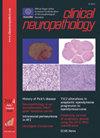Primary CNS EBV-positive post-transplant lymphoproliferative disorder with polymorphic and classic Hodgkin lymphoma features: A case report and literature review.
IF 0.8
4区 医学
Q4 CLINICAL NEUROLOGY
引用次数: 0
Abstract
Post-transplant lymphoproliferative disorders (PTLD) are typically Epstein-Barr virus (EBV)-associated lymphoid or plasmacytic proliferations that occur when immunosuppressed after transplantation. Only 2 cases of primary central nervous system (PCNS) classic Hodgkin lymphoma PTLD and 1 case of PCNS Hodgkin lymphoma-like PTLD have been previously reported. A 59-year-old male presented with malaise, headaches, and dizziness; neuroimaging revealed a 1.7-cm right cerebellar mass and a 0.6-cm right frontal mass. Microscopic examination demonstrated a perivascular and parenchymal polymorphous infiltrate composed of lymphocytes (CD3-positive T cells and CD20-positive B cells), plasma cells, and macrophages. Focally, macrophages had a spindled morphology with a fascicular arrangement amounting to poorly formed granulomata. Mitoses were seen. Scattered large atypical cells were visualized with irregular hyperchromatic nuclei, reminiscent of lacunar cells, mononuclear Hodgkin and binucleate Reed-Sternberg (RS) cells. EBV in situ highlighted a significant number of small lymphoid cells as well as many large atypical forms. Large atypical cells were seen to co-express CD15 and CD30. To our knowledge, this is the first such case with hybrid polymorphic PTLD and classic Hodgkin lymphoma features and the first such case to arise following liver transplantation. This case highlights the histological and immunophenotypic spectrum of these lymphoid proliferations and the resulting challenges in diagnosis and definitive subtyping.原发性中枢神经系统ebv阳性移植后淋巴增生性疾病伴多形和经典霍奇金淋巴瘤特征:1例报告并文献复习。
移植后淋巴细胞增生性疾病(PTLD)通常是eb病毒(EBV)相关的淋巴细胞或浆细胞增生,发生在移植后免疫抑制时。既往仅报道2例原发性中枢神经系统(PCNS)经典霍奇金淋巴瘤PTLD和1例原发性中枢神经系统霍奇金淋巴瘤样PTLD。1名59岁男性,表现为身体不适、头痛和头晕;神经影像学显示右侧小脑1.7 cm肿块和右侧额叶0.6 cm肿块。显微镜检查显示血管周围和实质多形态浸润,由淋巴细胞(cd3阳性T细胞和cd20阳性B细胞)、浆细胞和巨噬细胞组成。局部巨噬细胞呈纺锤形,呈束状排列,形成不良的肉芽肿。可见有丝分裂。可见分散的大的非典型细胞,细胞核不规则深染,使人联想到腔隙细胞、单核霍奇金细胞和双核Reed-Sternberg (RS)细胞。EBV原位突出了大量的小淋巴样细胞以及许多大的非典型形式。大型非典型细胞可同时表达CD15和CD30。据我们所知,这是第一例混合多态PTLD和经典霍奇金淋巴瘤特征的病例,也是肝移植后出现的第一例此类病例。本病例强调了这些淋巴细胞增生的组织学和免疫表型谱,以及由此带来的诊断和明确亚型的挑战。
本文章由计算机程序翻译,如有差异,请以英文原文为准。
求助全文
约1分钟内获得全文
求助全文
来源期刊

Clinical Neuropathology
医学-病理学
CiteScore
1.60
自引率
0.00%
发文量
70
审稿时长
>12 weeks
期刊介绍:
Clinical Neuropathology appears bi-monthly and publishes reviews and editorials, original papers, short communications and reports on recent advances in the entire field of clinical neuropathology. Papers on experimental neuropathologic subjects are accepted if they bear a close relationship to human diseases. Correspondence (letters to the editors) and current information including book announcements will also be published.
 求助内容:
求助内容: 应助结果提醒方式:
应助结果提醒方式:


